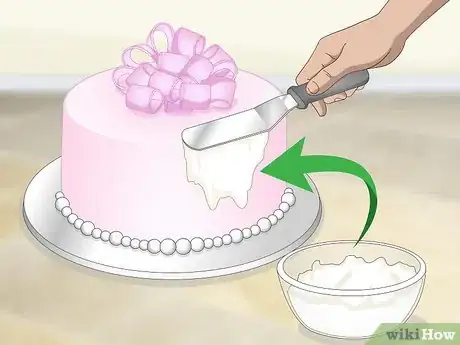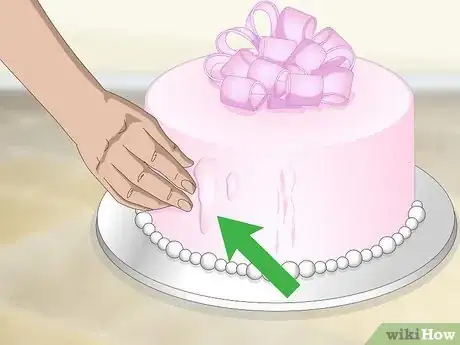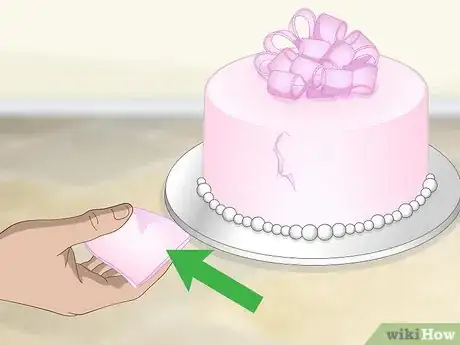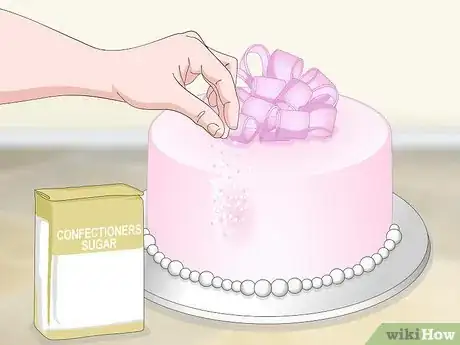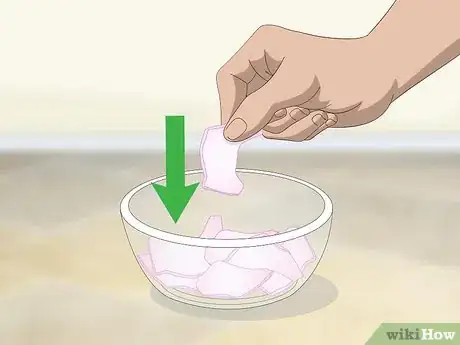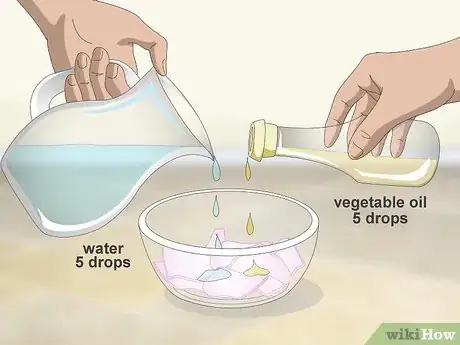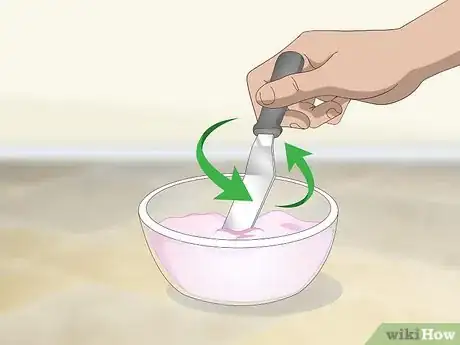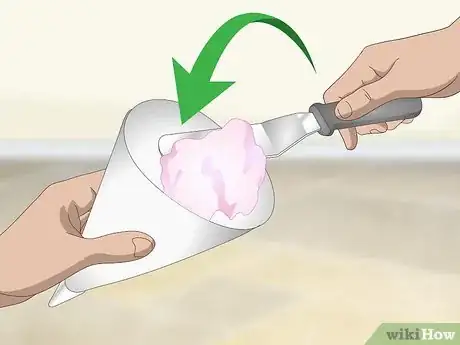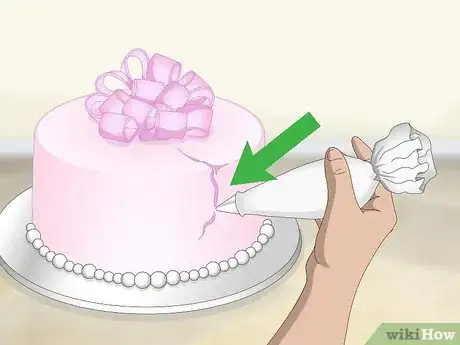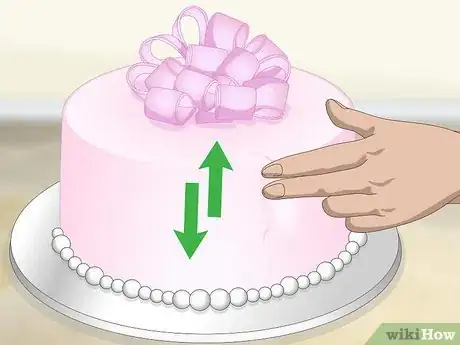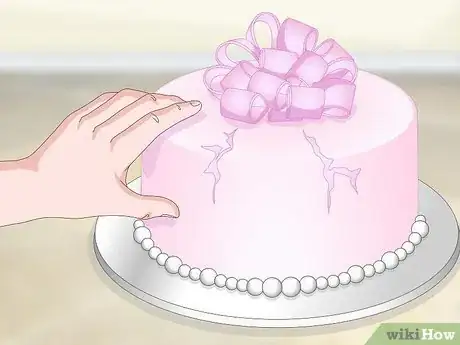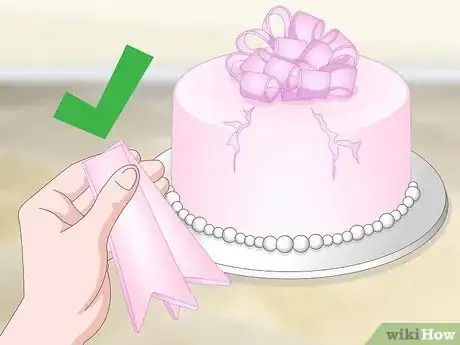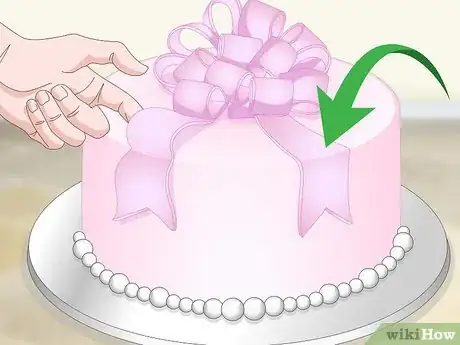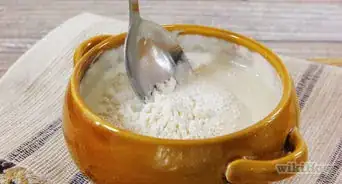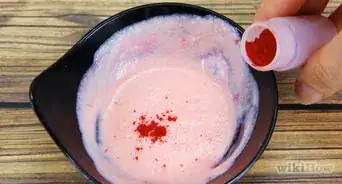This article was co-authored by Mathew Rice. Mathew Rice has worked in restaurant pastry kitchens across the country since the late 1990's, and currently owns Pink Door Cookies in Nashville. His creations have been featured in Food & Wine, Bon Appetit, and Martha Stewart Weddings. In 2016, Eater named Mathew one of the top 18 chefs to follow on Instagram. In 2018, he appeared in season 18 of the Food Network's Beat Bobby Flay and won his episode.
This article has been viewed 81,687 times.
Fondant icing is a great way to get a smooth, perfect cake surface, but it can easily crack! A cracked fondant can mar a beautiful cake, but don’t worry. Learning a few tricks to fix up cracks will help make your cakes come out perfect every time.
Steps
Preventing Cracks
-
1Frost the cake with buttercream or marzipan first. Putting fondant directly on the cake can lead to air bubbles, premature drying, and cracks. Before you put the fondant on, add a layer of buttercream or marzipan to your cake, then put the fondant on top of it. The moisture will hold it together perfectly![1]
- It's okay if your recipe doesn't specify adding buttercream or marzipan! You can do this anyway, it won't affect the look of the cake.
- This will also make your cake taste better! Many people dislike fondant because of its weak taste, but a hidden layer of frosting will sweeten your cake.
-
2Check your fondant for air bubbles, rough spots, and thickness. Most cracks happen because of a problem with the fondant itself. Before you put your fondant on, make sure it’s perfect. There should be no air bubbles, no rough spots, and the fondant should be the thickness specified in your recipe (this will change depending on what you’re making).[2]
- You can pop air bubbles with a sanitized needle before re-rolling the fondant.
- Rough spots can be massaged gently with a finger dipped in shortening.
EXPERT TIPMathew Rice has worked in restaurant pastry kitchens across the country since the late 1990's, and currently owns Pink Door Cookies in Nashville. His creations have been featured in Food & Wine, Bon Appetit, and Martha Stewart Weddings. In 2016, Eater named Mathew one of the top 18 chefs to follow on Instagram. In 2018, he appeared in season 18 of the Food Network's Beat Bobby Flay and won his episode.Professional Baker & Dessert Influencer
 Mathew Rice
Mathew Rice
Professional Baker & Dessert InfluencerDon't stress if it's not perfect. Mathew Rice, pastry chef, tells us: "Fondant is basically like adult playdough. If you mess it up, you can keep trying. It's very forgiving in that aspect."
Advertisement -
3Use your fondant immediately after making it. Fondant is meant to be used as soon as it’s rolled, so letting it sit for even a few minutes can have a drying effect that leads to cracked surfaces. To prevent cracks, use your fondant as soon as it’s rolled out.[3]
-
4Treat dry fondant with oil before you put it on. If your fondant feels dry as you’re rolling it or handling it, dip your hands in vegetable oil or shortening and gently rub the fondant’s entire surface. After it’s been treated, you can use it as you normally would.[4]
Patching Cracked Fondant
-
1Prepare a small piece of fondant. Take some of the fondant scraps left over from covering your cake and size them to the crack. The scrap you choose should cover the crack completely, with at least 1⁄4 inch (6.4 mm) of space surrounding the entire crack.
- If you already threw away the scraps before you noticed the crack, you can make a small batch by cutting your fondant recipe into quarters.
-
2Coat your fingers or an icing knife in oil or shortening. Get your index and middle fingers thoroughly coated in vegetable oil or shortening. It’s important to use oil for patching--water can melt the fondant and create even more cracks!
-
3Rub the fondant patch into the surface. Place the patch over the crack and gently massage the edges into the fondant with your oiled fingers. Don’t press down too hard. Just gently rub the patch in until the edges blend in with the fondant surface.
-
4Dust with confectioner’s sugar (optional). Take a pinch of confectioner’s sugar and gently dust the patch. This will help dry the new section of fondant and blend it even more seamlessly into the rest of the cake. This step is best for white or ivory-colored fondant--if your fondant is a different color, it’s best to skip this step to prevent a powdery effect.[5]
Piping Fondant into Cracks
-
1Put your fondant scraps into a bowl. If you’re piping in new fondant to cover a large crack in your cake, you’ll need to use all your fondant scraps so your piping bag works properly. Put all of them in a bowl. If you already threw out your fondant, make a quarter recipe of new fondant.[6]
-
2Add a few drops each of water and vegetable oil. To get the fondant to pipe, you’ll need to add moisture. Take four or five drops each of water and vegetable oil and add them to your bowl of fondant. Keep the water and oil out--you may need to add more.[7]
-
3Mix until it resembles a paste. Using an icing knife or your fingers, mix the liquid into the fondant until it looks like a paste. It should look very similar to eclair or cannoli filling. If nothing happens, add a few more drops of water and oil, one or two at a time, until you have a fondant paste.[8]
-
4Add the paste to a piping bag. Gently transfer your fondant paste into a piping bag. You can use any kind of bag with any tip for this, since you won’t be decorating with it. If you don’t have a piping bag, you can improvise by filling a plastic baggie with the paste and cutting the tip off one of the corners.[9]
-
5Pipe over the crack. Hold the piping bag up to the crack and gently squeeze until the entire crack is completely covered by the fondant paste. It’s okay if you put on a little too much or if it spills--it will all be blended in.[10]
-
6Use an icing knife or fingers to blend the piping in. Gently blend the paste into your cake until you can no longer see any evidence of the crack. You can use an icing knife or just your fingers, but you may want to cover them in oil first to prevent stickiness.[11]
-
7Dust with confectioner’s sugar (optional). Pick up a little bit of confectioner’s sugar in your fingers and dust the fondant paste. This helps dry the fondant and blend it even more seamlessly into the rest of the cake. You should only do this for white or ivory fondant, however--the white sugar will show up against colored fondant.[12]
Covering Cracks with Designs
-
1See if you can adjust your cake design to cover the crack. If you have a crack that can’t be fixed or is in a part of the cake meant to be decorated, you can cover it with a design. If you were planning to decorate your cake anyways, take a look at your design plans and see how they line up with the crack in your fondant. You might be able to simply proceed as usual instead of coming up with something special to cover the cracks.[13]
-
2Choose a design element to put over the crack. You can put any design you want over the crack as long as it covers it completely. Pick something that blends in well with your cake and the event you’re serving it at.
- Icing flowers are a classic choice and are very easy to make.
- You can cover cracks with cookies, candies, or chocolate disks.
- If the cracks are small enough, you can move any wording over to cover them.
-
3Cover the crack with your design. Gently place your design over the cracked fondant. If it’s a solid design like candy or even another piece of fondant, add a little buttercream frosting to the bottom to help it stick to the cake.[14]
-
4Blend it into the fondant if necessary. Some designs won’t require blending, but most frosting or fondant designs will need to be blended in. Dip your fingertips into vegetable oil and gently rub the edges of the design into the fondant until the entire thing blends in.[15]
Community Q&A
-
QuestionHow do you smooth fondant?
 Madeleine CampbellCommunity AnswerPlace the rolled fondant over the cake, smoothing out the top and sides with your clean palms (wash and dry them fully first). Then, trim away any excess fondant with a knife.
Madeleine CampbellCommunity AnswerPlace the rolled fondant over the cake, smoothing out the top and sides with your clean palms (wash and dry them fully first). Then, trim away any excess fondant with a knife. -
QuestionI have just rolled out fondant and put it on a cake, but it cracked around the edges and sides. I was told to knead the fondant well to prevent elephant skin. Could it be that I kneaded it too much?
 Camille ConnerCommunity AnswerAdd water to the cracked areas, or if that doesn't work, take the fondant off the cake and knead it until it is softer.
Camille ConnerCommunity AnswerAdd water to the cracked areas, or if that doesn't work, take the fondant off the cake and knead it until it is softer.
Things You'll Need
- Fondant
- Vegetable oil or shortening
- Water
- Icing knife
- Piping bag
- Bowl
- Decorative frosting, candies, or other design elements
Warnings
- If the fondant is cracked all across the cake, you may need to start over with a new batch of fondant.⧼thumbs_response⧽
References
- ↑ https://www.leaf.tv/articles/how-to-fix-cracked-fondant-on-a-cake/
- ↑ https://www.leaf.tv/articles/how-to-fix-cracked-fondant-on-a-cake/
- ↑ https://www.leaf.tv/articles/how-to-fix-cracked-fondant-on-a-cake/
- ↑ https://www.leaf.tv/articles/how-to-fix-cracked-fondant-on-a-cake/
- ↑ https://thehackneykitchen.wordpress.com/2014/07/18/fix-it-crack-in-fondant-covered-cake/
- ↑ https://thehackneykitchen.wordpress.com/2014/07/18/fix-it-crack-in-fondant-covered-cake/
- ↑ https://thehackneykitchen.wordpress.com/2014/07/18/fix-it-crack-in-fondant-covered-cake/
- ↑ https://thehackneykitchen.wordpress.com/2014/07/18/fix-it-crack-in-fondant-covered-cake/
- ↑ https://thehackneykitchen.wordpress.com/2014/07/18/fix-it-crack-in-fondant-covered-cake/
- ↑ https://thehackneykitchen.wordpress.com/2014/07/18/fix-it-crack-in-fondant-covered-cake/
- ↑ https://thehackneykitchen.wordpress.com/2014/07/18/fix-it-crack-in-fondant-covered-cake/
- ↑ https://thehackneykitchen.wordpress.com/2014/07/18/fix-it-crack-in-fondant-covered-cake/
- ↑ https://www.learncakedecoratingonline.com/how-to-troubleshoot-fondant/
- ↑ https://www.learncakedecoratingonline.com/how-to-troubleshoot-fondant/
- ↑ https://www.learncakedecoratingonline.com/how-to-troubleshoot-fondant/
About This Article
Fondant can easily crack, but if you have some extra fondant it’s simple to fix. To patch a big crack, first, roll out a small piece of fondant that’s big enough to cover the crack. Then, coat your fingers in a little vegetable oil and rub the fondant patch onto the cake until the edges of the patch blend in. Dust the patch with a tiny bit of confectioner’s sugar to help it dry and blend in better. If you have smaller cracks, you can pipe fondant directly into them. Mix together fondant scraps, 5 drops of water, and 5 drops of vegetable oil until it forms a paste. Then, use a piping bag to squeeze the mix onto the cracks. Again, you’ll need to use your fingers or an icing knife to blend the fondant into the rest of the cake. To learn how to prevent fondant cracks, read on!
